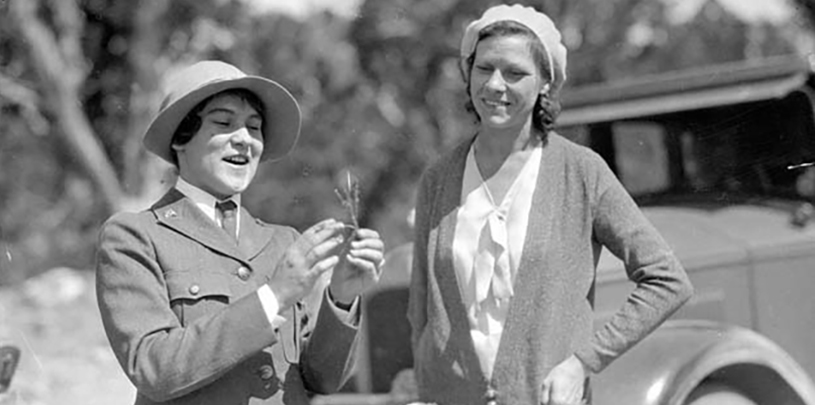
 by Ellen Heyn, Communications Manager
by Ellen Heyn, Communications Manager
When you’re a petite, blonde 20-something-year-old woman, national park backcountry offices can be where dreams of adventures die. Well, not so much die as get crushed with skepticism before rangers reluctantly hand over your golden ticket. Interactions have gone something like this:
“Are you sure you want this permit?”
“Yup.”
“You’re positive?”
“Mhm.”
“Have you done this before?”
“I have.”
“It’s a lot of miles.”
“I know.”
“So…you want the permit?”
“I do.”
I try not to take it personally — it’s the National Park Service’s job to keep visitors safe. But I can’t help but think if I was a foot taller, with a beard and booming voice, I’d get one question, not five.
It’s 2019, and I’m bemoaning gender bias in backcountry permits — a trivial complaint compared to inequities of past decades. Congress designated Grand Canyon National Park before it even granted women the right to vote. On this International Women’s Day, we’re celebrating the strong, tough, smart women everywhere, but especially in Grand Canyon National Park, which just commemorated its centennial anniversary.
Here’s a roundup of the trailblazers, artists, scientists, river runners, and other remarkable women who made history in the Grand Canyon.
 Nampeyo, surrounded by examples of her work, in 1900. NATIONAL ARCHIVES AND RECORDS ADMINISTRATION.
Nampeyo, surrounded by examples of her work, in 1900. NATIONAL ARCHIVES AND RECORDS ADMINISTRATION.
Following the Hopi tradition, Nampeyo learned how to make pottery by watching her mother dig and prepare clay, coil and scrape pots, and fire and hand-paint vessels. Nampeyo drew inspiration from 15th-century pot sherds she found near her home on First Mesa. In replicating the motifs, she developed her own style, becoming a leader of the Hopi pottery revival. In 1905, Nampeyo and her family lived at the Hopi House on the South Rim for three months, where she was the first live-in artist. Today, Hopi potters continue her legacy, melding tradition and innovation.
 Mary Colter, right, describing plans to Mrs. Ickes and Victor Pattroso, manager of El Tovar Hotel, circa 1935. NATIONAL PARK SERVICE.
Mary Colter, right, describing plans to Mrs. Ickes and Victor Pattroso, manager of El Tovar Hotel, circa 1935. NATIONAL PARK SERVICE.
If you’ve sipped a lemonade at Phantom Ranch, or stayed at Bright Angel Lodge on the South Rim, you’re familiar with Mary Colter’s work. She was a lady ahead of her time, as an architect for the Fred Harvey Company and the Santa Fe Railway in the early 1900s. Colter designed and supervised the construction of eight of Grand Canyon National Park’s most famous buildings, all of which still stand today.
 Elzada Clover on the first Nevills Expedition near Phantom Ranch, July 22, 1938. GRAND CANYON NATIONAL PARK.
Elzada Clover on the first Nevills Expedition near Phantom Ranch, July 22, 1938. GRAND CANYON NATIONAL PARK.
In 1938, Elzada Clover and Lois Jotter did what no woman and few men had ever done before: successfully raft through the Grand Canyon. The female botanists floated the Green and Colorado rivers in 43 days, cataloging the plants they found along the way. They published their findings six years later in a scientific journal under the title, “Floristic Studies in the Grand Canyon of the Colorado River and Tributaries.”
As a budding botanist, Pauline “Polly” Mead spent her early 20s studying the sharp division between meadows and forests on the North Rim for her master’s thesis (turns out it’s high lime content in soils). She went on to become the first woman ranger-naturalist at Grand Canyon National Park in August 1930, leading tours, interpretive talks, and nature hikes, until she married the park’s superintendent a year later.
 Georgie White in the canyon, circa 1957. GRAND CANYON NATIONAL PARK.
Georgie White in the canyon, circa 1957. GRAND CANYON NATIONAL PARK.
The Colorado River cast a spell on Georgie White, a fiercely independent woman who let nothing stand in her way. After swimming the Colorado River — twice — she became the first woman to row through the canyon and started her own rafting company called Georgie’s Royal River Rats. She fed her passengers canned stew, wore a leopard-print leotard, and pioneered the motorized rigs that run the river today.
80% of Arizona voters support Baaj Nwaavjo I'tah Kukveni National Monument, according to a new poll.
Read MoreThe Colorado River below Glen Canyon Dam is heating up. Find out why.
Read MoreGroundwater pumping at a uranium mine near the Grand Canyon will affect the canyon's springs, scientists says.
Read More